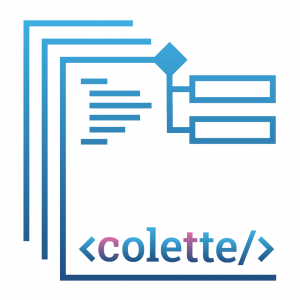Colette – Computational Thinking Learning Environment for Teachers in Europe

|
Website
Europees (Erasmus+) project 2020-2022 Penvoerder Partner in Nederland |
Lesmateriaal dat gebruikmaakt van XR, Augmented Reality
- Blokken bouwen in de lucht (nederlandstalig)
- Environment for AR programming (engelstalig)
[collapsibles]
[collapse title=”Abstract”]
Abstract
The digital transformation has fundamentally changed our life in the last years and will affect us and our life in ways today not even imaginable. Despite the sometimes excessive use and exposure to modern technology, the generation of the digital natives does not automatically develop sophisticated digital competences. As a consequence of the digital transformation, however, the development of the so called 21st century skills and competences is crucial for the participation in a rapid changing world and job market.
Computational Thinking (CT), as one of those skills, is a way of solving problems from the perspective of a computer scientist and formulating the problem in a form such as an algorithm that is easily readable for a machine or other human. Despite a stronger focus and various different approaches of embedding CT in formal education all over Europe, there are still many problems to be addressed. The availability of information technology varies considerably and thus often prevents the teaching of digital skills. Also, the socioeconomic status is unfortunately a strong predictor for CT skills and indicates towards the existence of a so-called digital divide. Even with sufficient and appropriate equipment at hand, the successful implementation of CT in the curricula requires support for in-service teachers providing them with trainings to learn about and deepen their understanding of CT. It is also necessary to offer a platform to share best practice examples amongst teachers and to create a corresponding community.
[/collapse]
[collapse title=”Aim”]
The idea of this project is to develop a learning environment which can be used to teach and learn CT independently from the socioeconomic background of the students and schools. Approaches to CT using hardware and modern technology (e.g. robots, 3D-printers) can be very motivating for students. However, there are many practical reasons such as the costs, safety concerns and the availability of the tools to only a small group of students at a time outweighing their possible benefits.
Using the technical possibilities of the digital transformation, we want to provide the students with an opportunity to learn CT without the requirement of buying additional hard- or software. Since nearly all students (91% in upper secondary schools) in Europe possess a smartphone, our approach aims at exploiting the benefits of the so-called Bring-Your-Own-Device-approach in a way that enables teachers to include CT in in their regular lessons.
[/collapse]
[/collapsibles]

Gerelateerde artikelen
Warning: Uninitialized string offset 0 in /hum/web/sitestest.hum.uu.nl/htdocs/wp-includes/class-wp-query.php on line 3766



